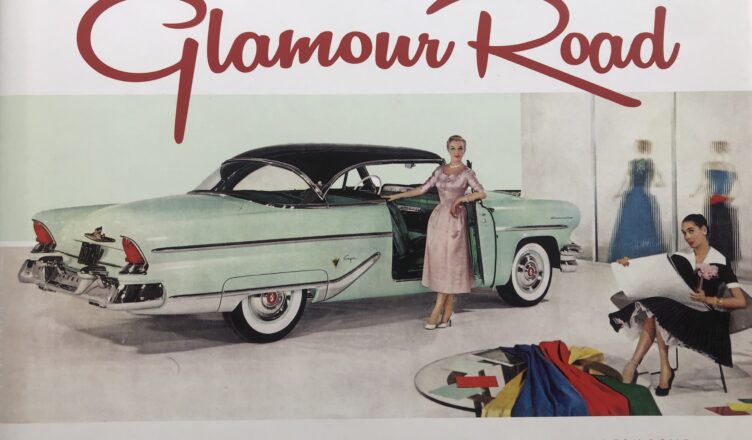Imagine it’s the 1950s and you’re living the post-war dream at the intersection of mid-century modern architecture, vibrant fashion, creative advertising, and a young generation of women who had yet to fully join their husbands in the workforce. All of this conspired to determine the cars America drove through the 1960s.
A book titled Glamour Road by Jeff Stork & Tom Dolle explores how cars from this era became embedded in our psyche.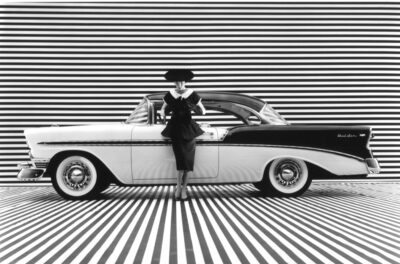
“I had done a piece for Automobile about the Damsels of Design, which I had been obsessed with for eons,” said Jeff Stork during a recent interview. “Tom reached out and said he wanted to do a book about the postwar era. We danced around it for a few years and right after we landed a publisher, the pandemic hit. It became our pandemic project.”
It was clearly a meeting of similar passions.
“I did a show at Pratt Institute in 2001, Selling the Dream, based on my collection of car brochures from the 50s-60s,” Dolle said. “I was always fascinated by the graphic design, illustration, and florid prose that elevated a mode of transportation into the American dream machine. When I came to Palm Springs, I looked up Jeff who had written many articles I admired along the same lines. I called him up and said we have to do a book together.” 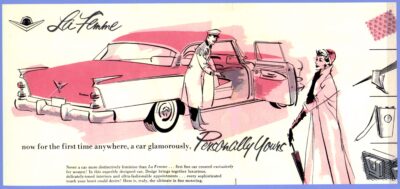
It would take a lock-down to collect the library of vibrant photos, period automotive advertisements, and mid-century designs to complete this epoch project. Every major American automaker and their stylists are represented. Even if you fancy yourself an expert of mid-century autos and style, you’ll find Glamour Road a master class by a team who knows their Eames from a Saarinen and Earl from a Loewy.
“The fashion industry was hired en-masse by car companies during the 50s and 60s – photographers, stylists, models, designers, etc.,” Dolle said. “They had a symbiotic relationship that helped create the greatest capitalist marketing success of all time and propelled the auto industry – especially General Motors – to be the largest and most powerful industry of the era.”
Detroit automakers were clearly influenced by the era’s greats. Alexander Girard, known for colorful textiles, hosted an exhibition for modern living at the Detroit Institute of Arts in 1949. His contemporaries like Eero Saarinen, Charles and Ray Eames, and George Nelson were all at Detroit’s Cranbrook Academy of Arts, an incubator for mid-century modernism.
GM’s legendary design chief, Harley Earl, likely attended Girard’s exhibition and knew the luminaries practicing at Cranbrook as he tapped Saarinen to design the GM Tech Center. These interactions influenced automobiles of the period.
“Glamour was an overriding concept of so much marketing in postwar America, from refrigerators to home design,” Dolle continued. “There was so much optimism and ‘fresh new world’ thinking. Car design was fascinated with rockets and the future, but inside there were glamorous textiles and elegant chrome details.”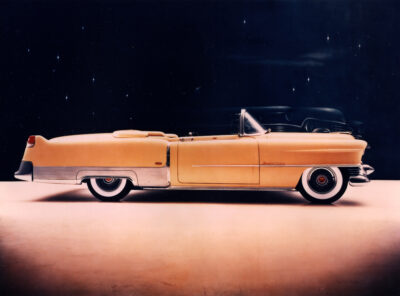
Of course, much of the power accessories, buttons, and dials were created to make driving easier for women. Mom wasn’t supposed to work or even have an opinion, but the rose and white 1955 Dodge LaFemme and befinned 1957 Cadillac Eldorado Brougham provided makeup cases and perfume atomizers just for her.
“Automobiles have always been a symbol of the era they were designed in, which is why Glamour Road is so powerful – it was a short period that will never be repeated. Vehicles have become much more ‘masculine’ and aggressive. How many oversized grey or black trucks and SUVs are on the road?!”
These gents drive what they preach. Stork curates a collection of postwar American automobiles that include a 1956 Packard Patrician, Volkswagen Beetle, and International Travelall, a forerunner to today’s SUVs. Dolle owns a 1964 Ford Country Squire wagon, 1967 Pontiac Grand Prix convertible, and 1972 AMC Javelin Pierre Cardin.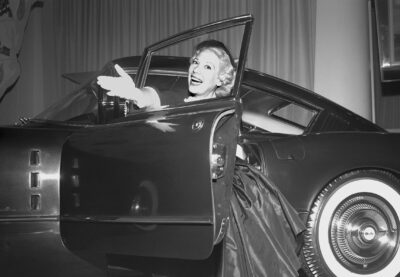
“I love Internationals,” Stork said.
“I love them all, when they are behaving,” Dolle added.
Given Stork’s knowledge of mid-century America, one wonders what designers he enjoys beyond cars.
“I’m fascinated by Charles and Ray Eames,” Stork said. “I love Raymond Loewy both for his industrial products and his automotive ones. And we’re both mesmerized by Alexander Girard who not only curated the color palette of the era but also injected whimsy.”
While the Eameses designed their iconic Lounge Chair, Loewy plied his craft at Studebaker plus created the Coke bottle and paint scheme on Air Force One. Against that backdrop, you needed a car to reflect the era’s style and optimism. Dinah Shore asked us to see the USA in our Chevrolets, and we complied.
“Postwar America was the exuberance of an unconquered nation,” Stork said. “We could do anything, and tomorrow was going to be better than today. It’s reflected in all of the consumer products of the era.”
Why don’t automakers make cars like these anymore?
“Everything is a virtually indistinguishable crossover,” Stork replied. “I think it’s because the role of the automobile has changed. It was a genuine status symbol in the postwar era. Now it’s a pair of Birkenstocks.”
Storm Forward!
